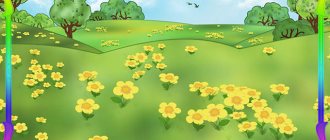Summary of educational activities for speech development for young children “Let's find friends by sound”
Publications on the topic:
Technological map for speech development for young children “Toys of our group” 1. Technological map for speech development for young children “Toys of our group”. 2. Topic: “Toys” 3. Age group:.
Abstract of the educational activity on speech development “Guess who came to us” for children of the second group of early age Topic: Speech. “Guess who came to us” Goal: developing the ability for dialogic speech Tasks: Develop clear pronunciation of sounds.
Summary of integrated direct educational activities for young children “Teremok invites friends” Integration of children's activities: - subject-based play (didactic games) - cognitive-research (didactic game p.
Summary of educational activities on speech development in the second group of early age. Reading the fairy tale “Confusion” by K. Chukovsky The main educational program of the preschool educational institution: From birth to school. Educational field: Speech development Age group: Second group.
Summary of educational activities on speech development “Toys” for children of preparatory age Purpose: Enrichment and activation of vocabulary on the topic. Objectives: 1. Correctional teaching to clarify, expand and activate the vocabulary on the topic.
Summary of educational activities for speech development in the early age group “Cockerel and his family. Poultry" Goal: development of cognitive interest in the study of poultry in combination with Russian folklore. Integration of areas: speech.
Abstract of the educational activity on speech development in the second group of early age “The Three Bears” Program content: “Cognitive development” To introduce children to the Russian folk tale “The Three Bears”, to instill an interest in looking at them.
Synopsis of an educational activity on speech development with elements of theatrical activities “Together we will find Spring” Synopsis of organized educational activities on speech development with elements of theatrical activities with children 4 - 5 years old.
Lapbook on the speech and cognitive development of young children Of course, in everyday life we are attentive to children’s expression of their desires, feelings, interests, questions, we strive to understand.
Summary of the lesson “Bird” on the speech development of young children. Summary of the lesson Topic: “Bird”. Objectives: To develop understanding and motivation of speech, to evoke an emotional response to an adult’s speech, to learn to highlight.
49362_Konspekt zanyatiya V gosti k Mashe 2 ml gr-.docx
Summary of the educational situation on sensory in the 2nd junior group Topic: “Visiting Masha” Compiled by: Karnetskaya T.I. Program content: 1. the ability to distinguish objects by color, shape and size; encourage children to name colors (red, blue, yellow, green); shapes (circle, square, triangle) 2. consolidate the idea of a square and a circle, triangle, promote the development of various types of children’s work during educational activities and 3. develop fine motor skills, tactility, imagination; 4. activate the words in children’s speech: ball, soft, boots, sundress, encourage them to say the words of finger gymnastics and playing with balls; 5. development of creative abilities - drawing up patterns according to the model 6. cultivate interest in understanding the world around us; cultivate friendly relationships; desire to help; 7. create favorable conditions for an emotionally positive perception of the material; 8. and avoid overworking children and muscle tension Methods and techniques: Verbal: (explanation, questioning, explanation, repetition and clarification, reminder, instructions for action, artistic expression). Visual: (demonstration of objects, demonstration of methods of action and construction of images). Practical: (demonstration of exercises, instructions, physical education). Stimulating: (praise, encouragement, emphasizing achievements, situation of success). Gaming: (creation of a plot game situation, sudden appearance of objects) Equipment and materials: 1. Masha’s house, magnetic board 2. Game sets “Froebel’s Gifts”. 3. Musical works: a phonogram of the sounds of nature and the noise of the forest, a melody for independent work. Progress and Introduction: Good morning! Good morning to everyone who woke up, Good morning to everyone who smiled! Good morning to people and birds, Good morning to friendly faces. Educator: Guys, remember, we read the fairy tale about Masha and the Bear, and today we received a letter... from Masha. Watching the video letter (Masha appears on the screen) Masha: Hello, guys! I have a problem...(cries), I was walking along the paths and tore all my boots, washed my sundresses, and all the patterns on them disappeared.... . (cries). Help me please guys... Educator: Oh, guys, Masha needs to help us, right? But how will you and I get into the Car fairy tale? Children's answers. Educator: And I know, so that we can get into a fairy tale, I have a magic chest. I have prepared a riddle for you and if you guess it, you will find out what is in the chest: Small in stature, but brave, he galloped away from me. Even though he is always inflated, there is never a dull moment with him. That's right, it's a ball! The teacher distributes textile balls to the children, focusing the children’s attention on the color of each one. - Vanya, what kind of ball do you have? and Vitya? Look how bright and beautiful they all are. Game “Balls” (Froebel, gift No. 1) We will play with them. We will take the balls in our hands and show them to each other. Now let’s squeeze them in our palms and roll them a little. Everyone sat down and stood up together. We showed the balls. Now let’s make a balloon (a circle of balloons with strings) and hit the road, let’s fly! Close your eyes and find yourself in a fairy tale! (A phonogram sounds with a recording of the noise of the forest and the singing of birds). We approach the house. Masha appears: - Hello, guys! Thank you for coming to help me. Here are my boots, I don’t know what to do…. (cries) ...how can I walk now... The boots are hanging on a magnetic board. Educator: Guys, how do you think we should sew them up? Children's answers. We need to help Masha put patches on her boots so that Masha can walk and run in them, you just need to choose a patch of the right shape (patches of different shapes: round, square, triangular). Children are divided into three subgroups and find the necessary patches and put them in place. Educator: Here, Masha, your boots are ready! Masha: Thank you very much! how beautiful! What to do with sundresses? Educator: Guys, let’s give Masha a treat and decorate her sundresses with beautiful patterns. Just let's stretch our fingers first. Finger gymnastics “To work” The thumb stood alone. The index finger is behind it. The middle one wakes up the nameless one. He raised his little finger. The brothers all stood up - “Hurray! “It’s time for them to go to work. Children sit at tables, next to each there is a silhouette of a sundress and colored figures: rings, sticks, circles on the floor. The teacher demonstrates samples of sundresses with patterns. The teacher explains what needs to be done: - You can take rings, sticks, semi-circles and decorate the sundress at your discretion, as your imagination tells you. Calm music sounds. Children begin to complete the task; in case of difficulty, the teacher provides individual assistance. Summing up Masha: Guys, you are all so great, you did such a good job, I really like your sundresses! Can I wear them in turn every day? Educator: Yes, Mashenka, of course, we were happy to help you! And now it’s time for the boys and I to go back to kindergarten. Children: Goodbye, Masha!
Card index of didactic games on sensory education for young children
Collect pencils into glasses
Material: colored pencils, cups of 4 colors.
Goal: To train children in the ability to compare colors, to help consolidate their knowledge of colors.
Colored pencils are laid out on the table in front of the children. The teacher puts one pencil of a different color in each glass,
pronouncing his actions: “I’ll put a blue pencil in this glass, let’s collect a lot of identical pencils.” And this is repeated with pencils of all primary colors. Encouraging children to say the color of the pencils.
What does the figure look like?
Target:
To develop children's ability to group objects according to shape
.
Game material: Geometric shapes cut out of dense material in 4 primary colors.
Progress of the game: Children are offered geometric shapes - circle, triangle, square. The adult names them. Asks children to find objects in the room or on the street that are similar to these figures. If possible, allows children to trace these objects with their hands (ball, hoop, cube, plate, aquarium, etc.)
.
Games for the development of auditory
perception
Multi-colored noisemakers
Material (waste, natural)
: plastic bottles filled with colored polyethylene granules, acorns (can be filled with sand, cereals, peas, beans, pasta).
Goal: develop auditory perception,
exercise the ability to determine the loud and quiet sound of
“noisemakers”
, develop a sense of rhythm.
Complication: develop color perception.
Who will hear what?
Material: screen, bell, drum, tambourine, pipe, etc.
Goal: to develop auditory perception, the ability to distinguish the sounds of different musical instruments.
They placed a screen in front of the children and rang a bell, banged a drum, a tambourine, played a pipe, etc. They asked the children to guess what object produced the sound.
Games for developing olfactory
perception
Guess the taste
Material: cut small pieces of vegetables and fruits (apple, pear, plum, orange, cucumber, carrot, radish, turnip, etc.) into a plate.
. Invite your baby to close his eyes and chew a piece.
Goal: Enrich children's sensory sensations: determine what kind of taste it was (sweet, sour, bitter, salty)
and what is the name of what the child eats.
What smells?
Material: jars containing a gauze bag with pieces of apple, lemon, garlic, coffee beans and other fillings.
Goal: To enrich children’s sensory sensations: to exercise the ability to determine by smell what it smells like (apple, lemon, garlic, coffee, to develop fine motor skills.
Complication: practice naming colors.
An adult creates a game situation: “Flowers have grown in the clearing. Let's look at them and smell them! What do they smell like? What color are they?"



